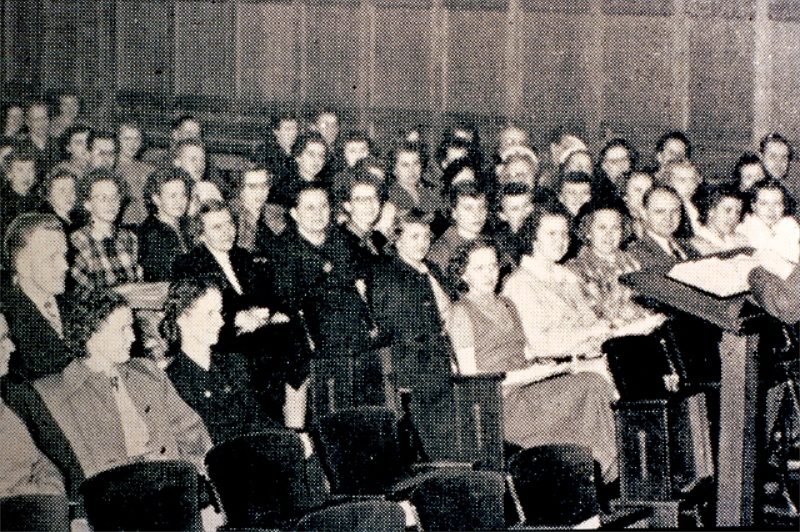Last month we identified an historical milepost from two hundred years ago: the conversion of Hans Nielsen Hauge of Norway, on April 5, 1796.
A dynamic “Haugeaner” revival followed this singular conversion. Communities throughout the Norwegian countryside were convicted of sin, as Hauge had been, then energized by the wonderful gospel of Jesus. Faith was awakened. Hearts were transformed. And missionaries were sent! In the century that followed Hauge’s conversion – what Kenneth Scott Latourette has called the “Great Century” of missionary expansion – Norway sent more missionaries per capita than virtually any nation on Earth.
In May, we come to another significant milepost. The spiritual power of Hauge’s revival “like a flame in the wind made a jump across the Atlantic.” 1 And it landed in Minneapolis! On May 25, 1937, on the campus of the Lutheran Bible Institute of Minneapolis, the South American Mission Prayer League (SAMPL) was born 2 – the little fellowship that was to become the World Mission Prayer League. 3

Our little fellowship stood in direct continuity with Hans Nielsen Hauge. “God put faith, prayer and a real desire for soul-winning… into the hearts of a number of younger Christians,” the Hauge Inner Mission Federation reported in 1941. 4 And these “younger Christians” – Lutheran, “Haugeaner,” eager and believing Bible School students – were us.
I have recently read an interesting dissertation presented to the Department of Scandinavian Studies at London University College, in 2007. Alison Stibbe examined Hauge’s message with a view to discovering its specific power to transform lives. 5 How do “younger Christians” get “faith, prayer and a real desire for soul winning”?
Stibbe based her analysis in the perspective of Walter Brueggemann’s well-known classic, The Prophetic Imagination. 6 She finds in Hauge something more than a simple Scandinavian revivalist; he was a prophet, in the sense that Brueggemann famously describes.
Prophets “speak new futures into being,” Brueggemann asserted. They “deconstruct” the fusty status quo that will dull our hearts, stifle our imaginations, impair our sense of confidence and obedience – and invariably deaden our participation in the mission of God. This deconstruction is the task of prophetic “criticism.”
And then prophets “energize” things. They “construct” a radically alternative point of view – based in trust and confidence, leaning toward obedience, fueled by hearts of flesh instead of stone, and participating gladly in the wonderful mission of God. Prophets “criticize,” then they “energize”: these become the “prophetic imagination,” in the model of Walter Brueggemann.
This is what Stibbe sees in the ministry of Hans Nielsen Hauge. I think that she is right.
Hauge’s Pietism “criticizes” a status quo that values pastors over lay people, “professionals” over the less-well prepared, and the educated class over those without so very many degrees. Pietism believes that the mission of God belongs to the entire people of God. It does not belong to pastors in some unique sort of way. Theologians have no corner on the things of God, and professionals do not corner significance or truth. The grace and mission of God call and equip everyone.
It was this sort of “criticism” that got Hauge into trouble: it seemed a direct threat to established church hierarchies – and landed Hauge in jail. It was precisely this perspective, however, that “energized” the faith and obedience of entire broad communities of faith – men and women, young and old, lay and ordained, “white collar” professionals and others who wore blue.
Hauge’s message “increased [the] level of self-awareness and self-confidence in the receiver,” Stibbe explains. Hauge’s followers “experienced a form of inner emancipation which led to outer action.” 7 Once they were no people; now they were God’s people. Once they had not received mercy; now they had (1 Peter 2:10). This was the “spark” that jumped the Atlantic and landed on the campus of the Lutheran Bible Institute in Minneapolis – a radical, adventurous, faith-filled way of viewing things. It was, you might say, a “missionary imagination.”
And Stibbe is right about this, as well: Hauge’s message has been “gradually domesticated over the last two centuries.” It is important, Stibbe suggests, to let Hauge loose again – to permit the man “to reassume the radical and untamed side of his nature.” 8
The Lutheran Bible Institute, of course, is long gone. Yet the same sort of “spark” that once flamed there remains in the air, if we have the eyes to see it. There is something “radical” and “untamed” about this flame. It remains as vital and as needful as ever before.
And if you listen carefully you may come to agree: this “spark” crackles. This spark still burns. Listen carefully! – you may hear it, still, “speak new futures into being.”
2 Mildred Tengbom, The Spirit of God was Moving (Minneapolis: World Mission Prayer League, 1985), p.27.
3 The World Mission Prayer League was incorporated in 1945.
4 Hauge Inner Mission Federation, op.cit., p.365
5 Alison Heather Stibbe, Hans Nielsen Hauge and the Prophetic Imagination, unpublished dissertation (London: University College, Department of Scandinavian Studies, 2007)
6 Walter Brueggemann, The Prophetic Imagination, 2nd ed. (Minneapolis: Fortress, 2001)
7 Stibbe, op.cit., p.331
8 ibid., p.334
Other posts in this Mileposts series: